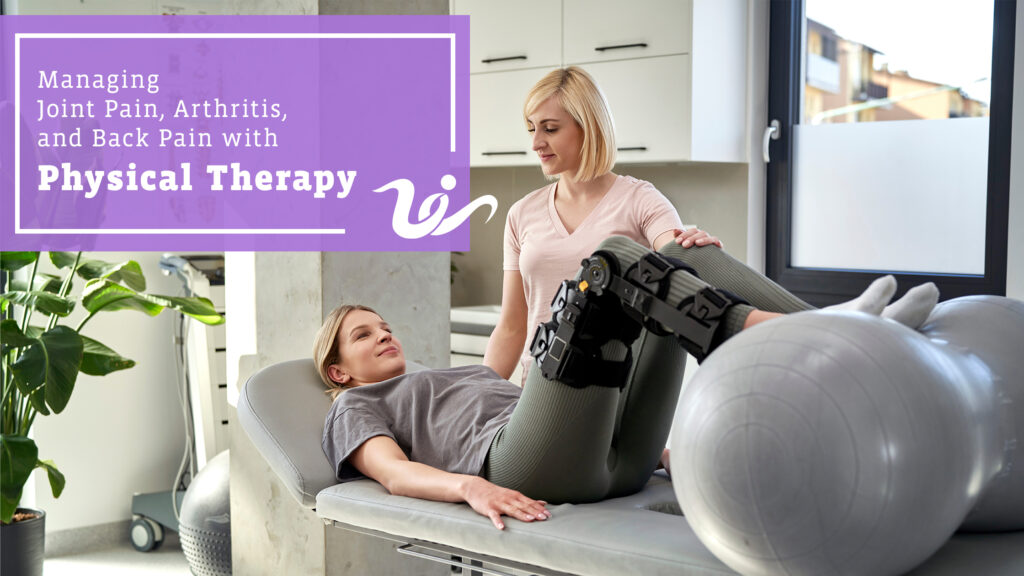Dealing with joint pain, arthritis, and back pain can be tough, but you’re not alone—and there’s hope! At our physical therapy practice, we see these challenges every day and know firsthand how transformative the right approach can be. Physical therapy (PT) offers powerful solutions to manage these conditions effectively. We’re excited to share some practical tips you can try at home, along with professional insights that can make a real difference in your life. Read on to discover how you can take control of your pain—and remember, we’re here to create a custom plan just for you (because one size does not fit all!)
Joint Pain and Its Causes
Joint pain can result from various factors, including injury, arthritis, and wear and tear over time. It’s essential to understand that joints are complex structures involving bones, cartilage, ligaments, and tendons, all working together to facilitate movement. When any part of this structure is compromised, pain can occur.
The Role of Physical Therapy
Physical therapy focuses on restoring movement and function while reducing pain. Here’s how PT can help manage joint pain:
- Strengthening Muscles: Strong muscles around the joints provide better support and reduce the strain on the joints.
- Improving Flexibility: Flexibility exercises help maintain the range of motion in your joints.
- Reducing Inflammation: Specific PT techniques can help reduce inflammation and improve joint function.
Tips for Managing Joint Pain at Home
- Gentle Stretching Exercises
Stretching helps maintain flexibility and range of motion. Try these simple stretches:
– Hamstring Stretch: Sit on the floor with one leg extended and the other bent. Reach towards your toes while keeping your back straight. Hold for 20 seconds and switch legs.
– Shoulder Stretch: Bring one arm across your body and use the opposite hand to gently pull it closer to your chest. Hold for 15-20 seconds.
- Strengthening Exercises
Strengthening the muscles around your joints can alleviate pain. Here are a couple of easy exercises:
– Quad Sets: Sit with your legs extended. Tighten the muscles on top of your thigh (quads) and hold for 5 seconds. Repeat 10 times.
– Wall Push-Ups: Stand facing a wall. Place your hands on the wall at shoulder height and width. Slowly bend your elbows and lean towards the wall, then push back. Do this 10-15 times.
- Low-Impact Aerobic Exercises
Activities like walking, swimming, or cycling can improve your overall fitness without putting too much stress on your joints.
- Hot and Cold Therapy
Use heat to relax muscles and increase blood flow, and cold to reduce inflammation and numb the area. A warm towel or heating pad can be used for heat therapy, while an ice pack or a bag of frozen peas works for cold therapy. You really don’t need anything fancy for practical relief!
Understanding the Pain-Inflammation Cycle
When a joint is injured or overused, inflammation occurs as the body’s natural response. This inflammation can cause pain and stiffness, leading to decreased movement. Reduced movement further weakens the surrounding muscles, exacerbating the problem. Physical therapy breaks this cycle by using targeted exercises to reduce inflammation and strengthen the muscles.
Neuromuscular Re-Education
One advanced PT technique is neuromuscular re-education. This method retrains the nervous system and muscles to improve movement patterns and joint stability. It’s particularly beneficial for people with chronic joint pain, as it helps restore normal function and reduce compensatory movements that can lead to further pain.
Manual Therapy
Manual therapy involves hands-on techniques to mobilize joints and soft tissues. Techniques like joint mobilization and soft tissue massage can improve joint function and reduce pain. As PTs, we have specialized training to perform these techniques effectively and safely. Managing joint pain, arthritis, and back pain is possible with the right approach. Incorporating these PT tips into your daily routine can make a significant difference. Remember, every individual’s condition is unique, so it’s always a good idea to consult with a physical therapist to tailor a plan that suits your specific needs.
Stay active, stay healthy, and take care of your joints! Feel free to reach out if you have any questions or need personalized advice. We’re here to help you move better and live pain-free.



